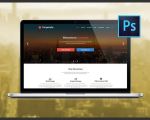- 1-Understanding-Responsive-Design
- 2-Mobile-First-Approach
- 3-Fluid-Grids-and-Flexbox
- 4-Media-Queries-and-Breakpoints
- 5-Optimizing-Images-and-Media
- 6-Effective-CTA-Placement
- 7-Performance-and-Testing
- 8-Case-Study-and-Resources
1. Understanding Responsive Design
When you learn how design website responsive landing page, the first step is grasping core principles of responsive design. A responsive landing page adapts to different screen sizes—phones, tablets, and desktops—providing an optimal user experience. This means fluid layouts, flexible images, and CSS rules that adjust elements dynamically. Reactive design not only improves usability but also boosts SEO rankings, as search engines favor mobile-friendly pages.
1.1 Why Responsiveness Matters
Over half of web traffic comes from mobile devices. A landing page that fails to render properly on small screens risks high bounce rates and lost conversions. Responsive techniques ensure content remains legible, buttons tappable, and navigation intuitive across devices.
2. Mobile-First Approach
Adopting a mobile-first strategy helps answer “how design website responsive landing page” effectively. Start by designing and coding for the smallest screens, then progressively enhance for larger viewports. This ensures essential content loads quickly and secondary features are added only when space allows.
2.1 Prioritizing Content
Map out user goals—newsletter sign-up or product demo—and place primary call-to-action above the fold on mobile layouts. Secondary links and images can follow, preserving hierarchy without overwhelming limited real estate.
3. Fluid Grids and Flexbox
Fluid grids use percentage-based widths instead of fixed pixels, allowing elements to scale proportionally. CSS Flexbox further simplifies responsive arrangements by distributing space within a container, aligning items, and managing wrapping behavior.
3.1 Implementing a Fluid Grid
Define a container width of 100% and assign child elements widths like 50% or 33.33%. This way, two or three columns adjust automatically to the screen size, stacking on narrower viewports.
3.2 Flexbox Techniques
Use display:flex; and flex-wrap:wrap; on parent elements. Control individual item flexibility with flex:1 1 200px;—grow, shrink, and base width—ensuring cards or feature blocks adapt smoothly.
4. Media Queries and Breakpoints
Media queries apply CSS rules at specified viewport widths, known as breakpoints. Choosing logical breakpoints—where your layout naturally requires adjustment—ensures fluid transitions rather than abrupt shifts.
4.1 Common Breakpoints
Standard breakpoints include 320px (small phones), 768px (tablets), and 1024px (desktops). Customize these based on your design’s needs, adjusting typography, padding, and column counts accordingly.
4.2 Query Syntax
Use @media (max-width: 767px) { … } for mobile-specific rules, and @media (min-width: 768px) { … } for tablet and above. Organize queries mobile-first to keep styles cascading naturally.
5. Optimizing Images and Media
Large files slow page loads, hurting user experience and SEO. To design a responsive landing page, optimize all media through compression, responsive formats, and lazy loading.
5.1 Responsive Images
Implement the <picture> element or srcset attribute to serve different image resolutions based on device pixel densities and viewport widths.
5.2 Lazy Loading
Defer offscreen images and videos using the loading="lazy" attribute or JavaScript libraries. This reduces initial load time and preserves bandwidth for critical content.
6. Effective CTA Placement
Strategic call-to-action (CTA) positioning drives conversions on a landing page. When calculating how design website responsive landing page, ensure CTAs remain prominent across breakpoints.
6.1 Sticky Buttons
On mobile, use a sticky footer or header bar for your primary CTA—“Sign Up” or “Get Started”—so it’s always within thumb reach without scrolling.
6.2 Hierarchical CTAs
Use clear visual hierarchy: primary CTAs in bold colors and large buttons, secondary CTAs in outlined or muted styles. Maintain spacing to prevent accidental taps on small screens.
7. Performance and Testing
Responsive design goes hand in hand with performance optimization. Regular testing across devices and network conditions uncovers issues early.
7.1 Tools for Testing
Use browser dev tools to simulate various devices, Lighthouse for performance audits, and real-device testing services like BrowserStack for accurate results.
7.2 Monitoring Metrics
Track Core Web Vitals—Largest Contentful Paint, First Input Delay, and Cumulative Layout Shift—to ensure your landing page meets user-centric performance benchmarks.
8. Case Study and Resources
At SitePoint 24, we redesigned our webinar sign-up landing page following these principles. By switching to a mobile-first layout, reducing images by 60%, and adding a sticky CTA, we saw a 35% increase in conversions on smartphones. For templates, frameworks, and tutorials on how design website responsive landing page, explore SitePoint 24’s resource library, where curated guides and code snippets accelerate your responsive design workflow.








